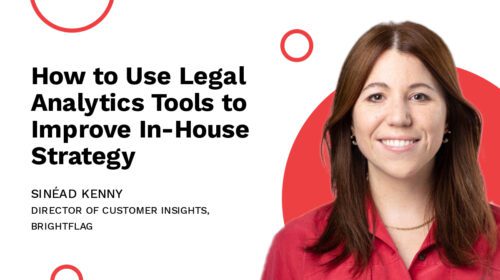How to Secure Budget for New Legal Tech Tools
When it comes to making the case for additional investments in the legal department, in-house teams face an uphill battle.
Between ever-increasing workflows, stagnant headcounts, and rising outside counsel rates, it can feel like the legal department’s budget is under constant duress (and scrutiny).
New legal technology tools can help stretch those limited resources further—but as with any expense, you’ll have to make a compelling case for it before getting organizational approval. With that in mind, let’s dive into how (and when) to build the most effective argument for securing the budget for the legal tech tools you need.
When to Start Building the Case for New Legal Technology
The ideal time to start building a case for any new legal department investments is during annual financial planning season. That’s because next year’s budgets are in the process of being created—which means resources can be carved out or reallocated ahead of time. This makes securing those investments and the necessary approvals significantly easier.
Who Do You Need to Convince to Secure Buy-In for a New Legal Technology Investment?
It used to be the case that the General Counsel held all the power when it came to deciding whether to onboard a new piece of legal technology. Nowadays though, organizations typically have a more protracted approval process—which means there are significantly more stakeholders to appeal to when it comes to making the case for additional resources.
That’s not to say your GC won’t have a say, of course. In fact, you’ll have to secure their buy-in first for the request to gain any traction. With that in mind, your initial pitch will likely have to focus on the strategic benefits the tech you’re pursuing will provide to the legal team (e.g. full visibility into legal spend, attorneys spending less time on menial tasks, etc.).
Your finance department—and your CFO in particular—will also likely play a big role in the final decision. And as you might expect, they’ll be particularly interested in knowing the cost breakdown of the technology, and what kind of return on investment it can be expected to provide.
The other key stakeholders you’ll want to convince will likely depend on the technology you’re advocating for. For example, if it’s an e-billing tool you’re after, illustrating how it will streamline the workflows of your Financial Planning & Analysis (FP&A) partner is a great way to add them as a champion when building your case. Or if you’re looking to secure a Contract Lifecycle Management (CLM) tool, showcasing to the Sales team how it can speed up contract review might spur them to help push for the deal on their end as well.
Key Points to Address When Advocating for New Legal Technology Tools
Cost Savings
A point that will resonate with legal and finance leadership alike is that the tool you’re advocating for will end up paying for itself—and then some—in the long run.
You can build this argument by leaning on case studies from vendors you’re considering, and speaking with other users of the legal tech tool to learn more about the ROI they were able to secure. Some vendors, like Brightflag, even offer ROI calculator tools to give you an estimate of how much your legal team might expect to save based on a few key details about your legal department.
Time Savings
The members of your in-house team specialize in protecting the business from risk, so it’s not in anyone’s best interest for them to spend large amounts of time on administrative tasks.
Fortunately legal tech tools streamline a lot of time-consuming work like legal invoice review and contract review. In the case of the former, a platform like Brightflag can even leverage AI to automate invoice review and approval so that a portion of invoices never need to cross your attorneys’ desks.
When making the case for new legal tech, create a baseline of how many hours your team spends manually doing administrative work today. Then, estimate how many of those hours can be saved by implementing efficiency-increasing technology.
Greater Visibility into Legal Work and Spend
Some forms of legal technology deliver not only ‘hard’ cost savings, but improve the operation of the legal department by providing greater oversight of ongoing work, and visibility into costs.
A legal e-billing tool is an example of this kind of technology, as it provides greater visibility into how your legal budget is being spent. The great thing about advocating an e-billing tool during budgeting season is that you can clearly illustrate the ways it will help improve the financial planning process in real-time.
Do you currently have to dig through spreadsheets to find the spend data you’re looking for while building your budget? Explain how having a tool in place that provides real-time insight into legal spend will increase the accuracy of your financial forecasts.
This argument will resonate particularly well with your FP&A partner, who legal often works closely with during annual budget planning season, and who would benefit immensely from easier access to your spend data.
Improved Reputation of Legal
It’s no secret that some organizations view legal as a cost center. This is, of course, a mischaracterization—and one that your GC or CLO is likely to be interested in combatting.
By onboarding a legal tech tool, your legal team can position themselves as a proactive and strategic partner to the business. By reaping the benefits mentioned above—lower costs, better insights into resourcing, and more time spent on the tasks that matter most to the organization—legal tech tools can really showcase the value that legal brings to the table.
Learn What E-Billing and Matter Management Can Do
You now know when and how to advocate for the budget you need to add a new legal tech tool. Now the question is which tool to focus on securing.
In talking with in-house legal teams, we often hear how foundational implementing an e-billing and matter management system is. That’s because it helps automate a lot of painful processes like invoice review, collecting accruals, spend reporting, and more. Additionally, with outside counsel spend comprising nearly half of most legal departments’ budgets, being able to effectively manage this spend can have an outsized impact on the in-house team’s budget.
If you’re interested in joining the growing number of legal departments that are implementing an e-billing and matter management system, book a demo with Brightflag today and see how our AI-backed platform can transform what your legal team is capable of.



